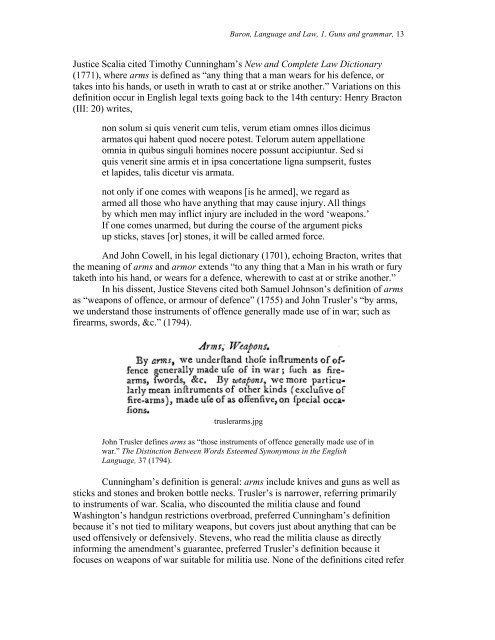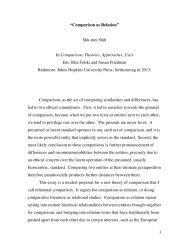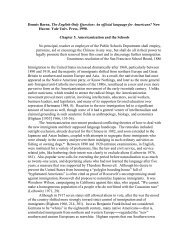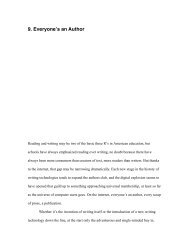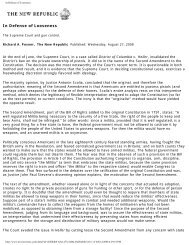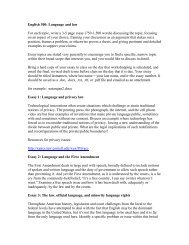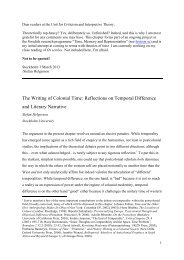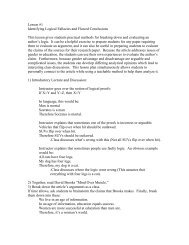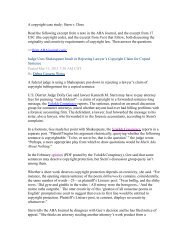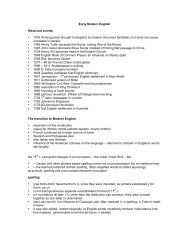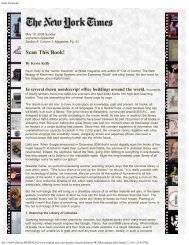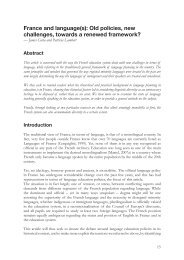Baron, Language <strong>and</strong> Law, <strong>1.</strong> <strong>Guns</strong> <strong>and</strong> grammar, 12government or even to check <strong>and</strong> balance <strong>the</strong> army. Instead, <strong>the</strong> militia is a militaryarm of both <strong>the</strong> states <strong>and</strong> <strong>the</strong> federal government which may be called upon asneeded to enforce <strong>the</strong> law. As we saw when Pres. Eisenhower called out <strong>the</strong> NationalGuard to enforce federal desegregation in <strong>the</strong> Little Rock schools, or when GeorgeBush sent <strong>the</strong> National Guard to fight in Iraq, <strong>the</strong> job of <strong>the</strong> militia has always beento reinforce <strong>the</strong> st<strong>and</strong>ing army in putting down domestic insurrections <strong>and</strong> repellingforeign threats.The <strong>Second</strong> Amendment was revised <strong>and</strong> sharpened before it was finallypassed. During this editing, <strong>the</strong> militia clause was not cut from <strong>the</strong> amendment,though ano<strong>the</strong>r provision was discarded which dealt with conscientious objectors—Quakers who, though <strong>the</strong>y may have hunted for food, consistently refused to beararms. A version of <strong>the</strong> <strong>Second</strong> Amendment approved by <strong>the</strong> Senate shows a slightlydifferent wording: “a well regulated militia, being <strong>the</strong> best security of a free state,<strong>the</strong> right of <strong>the</strong> people to keep <strong>and</strong> bear arms, shall net [sic] be infringed” (Journal1789-93). The final version of <strong>the</strong> <strong>Second</strong> Amendment was rewritten yet again toread, “A well regulated Militia, being necessary to <strong>the</strong> security of a free State,”placing continued emphasis on <strong>the</strong> importance of <strong>the</strong> militia, a fur<strong>the</strong>r reason not todismiss <strong>the</strong> importance of <strong>the</strong> <strong>Second</strong> Amendment’s absolute construction.And yet that is <strong>what</strong> Justice Scalia does in his opinion. Scalia acknowledgesthat <strong>the</strong> militia is a subset of Americans, but that very fact reinforces <strong>the</strong> distinctionhe <strong>the</strong>n makes between <strong>the</strong> militia <strong>and</strong> <strong>the</strong> people:<strong>the</strong> “militia” in colonial America consisted of a subset of “<strong>the</strong>people”—those who were male, able bodied, <strong>and</strong> within a certain agerange. Reading <strong>the</strong> <strong>Second</strong> Amendment as protecting only <strong>the</strong> right to“keep <strong>and</strong> bear Arms” in an organized militia <strong>the</strong>refore fits poorlywith <strong>the</strong> operative clause’s description of <strong>the</strong> holder of that right as“<strong>the</strong> people.”We start <strong>the</strong>refore with a strong presumption that <strong>the</strong> <strong>Second</strong>Amendment right is exercised individually <strong>and</strong> belongs to allAmericans.To keep <strong>and</strong> bear arms . . . Heller, 7The militia clause survived rounds of editing by <strong>the</strong> framers only to be summarilydeleted by Justice Scalia because of its poor fit with <strong>the</strong> “operative clause.” Ano<strong>the</strong>rproblem in interpretation concerns meaning of arms, <strong>and</strong> <strong>what</strong> it means to bear<strong>the</strong>m. From <strong>the</strong> discussions in oral arguments as well as in Justice Scalia’s opinion<strong>and</strong> Justice Stevens’ dissent, it’s apparent that <strong>the</strong> justices define <strong>the</strong> bearing of armsin ways that support <strong>the</strong>ir overall sense of <strong>what</strong> <strong>the</strong> <strong>Second</strong> Amendment guarantees,<strong>and</strong> <strong>what</strong> it does not. In this section, we’ll look specifically at how dictionaries cameinto play to answer some of <strong>the</strong>se questions.Given that <strong>the</strong> <strong>Second</strong> Amendment guarantees a right related to arms, <strong>the</strong>justices took care to consider <strong>what</strong> arms might mean in <strong>the</strong> framers’ day, <strong>and</strong> <strong>what</strong> itrefers to today. Along with <strong>the</strong> dictionaries of Samuel Johnson <strong>and</strong> Noah Webster,
Baron, Language <strong>and</strong> Law, <strong>1.</strong> <strong>Guns</strong> <strong>and</strong> grammar, 13Justice Scalia cited Timothy Cunningham’s New <strong>and</strong> Complete Law Dictionary(1771), where arms is defined as “any thing that a man wears for his defence, ortakes into his h<strong>and</strong>s, or useth in wrath to cast at or strike ano<strong>the</strong>r.” Variations on thisdefinition occur in <strong>English</strong> legal texts going back to <strong>the</strong> 14th century: Henry Bracton(III: 20) writes,non solum si quis venerit cum telis, verum etiam omnes illos dicimusarmatos qui habent quod nocere potest. Telorum autem appellationeomnia in quibus singuli homines nocere possunt accipiuntur. Sed siquis venerit sine armis et in ipsa concertatione ligna sumpserit, fusteset lapides, talis dicetur vis armata.not only if one comes with weapons [is he armed], we regard asarmed all those who have anything that may cause injury. All thingsby which men may inflict injury are included in <strong>the</strong> word ‘weapons.’If one comes unarmed, but during <strong>the</strong> course of <strong>the</strong> argument picksup sticks, staves [or] stones, it will be called armed force.And John Cowell, in his legal dictionary (1701), echoing Bracton, writes that<strong>the</strong> meaning of arms <strong>and</strong> armor extends “to any thing that a Man in his wrath or furytaketh into his h<strong>and</strong>, or wears for a defence, wherewith to cast at or strike ano<strong>the</strong>r.”In his dissent, Justice Stevens cited both Samuel Johnson’s definition of armsas “weapons of offence, or armour of defence” (1755) <strong>and</strong> John Trusler’s “by arms,we underst<strong>and</strong> those instruments of offence generally made use of in war; such asfirearms, swords, &c.” (1794).truslerarms.jpgJohn Trusler defines arms as “those instruments of offence generally made use of inwar.” The Distinction Between Words Esteemed Synonymous in <strong>the</strong> <strong>English</strong>Language, 37 (1794).Cunningham’s definition is general: arms include knives <strong>and</strong> guns as well assticks <strong>and</strong> stones <strong>and</strong> broken bottle necks. Trusler’s is narrower, referring primarilyto instruments of war. Scalia, who discounted <strong>the</strong> militia clause <strong>and</strong> foundWashington’s h<strong>and</strong>gun restrictions overbroad, preferred Cunningham’s definitionbecause it’s not tied to military weapons, but covers just about anything that can beused offensively or defensively. Stevens, who read <strong>the</strong> militia clause as directlyinforming <strong>the</strong> amendment’s guarantee, preferred Trusler’s definition because itfocuses on weapons of war suitable for militia use. None of <strong>the</strong> definitions cited refer
- Page 1 and 2: 1. Guns and Grammar: Determining wh
- Page 3 and 4: Baron, Language and Law, 1. Guns an
- Page 6 and 7: Baron, Language and Law, 1. Guns an
- Page 8 and 9: Baron, Language and Law, 1. Guns an
- Page 10 and 11: Baron, Language and Law, 1. Guns an
- Page 14 and 15: Baron, Language and Law, 1. Guns an
- Page 16 and 17: Baron, Language and Law, 1. Guns an
- Page 18 and 19: Baron, Language and Law, 1. Guns an
- Page 20 and 21: Baron, Language and Law, 1. Guns an


